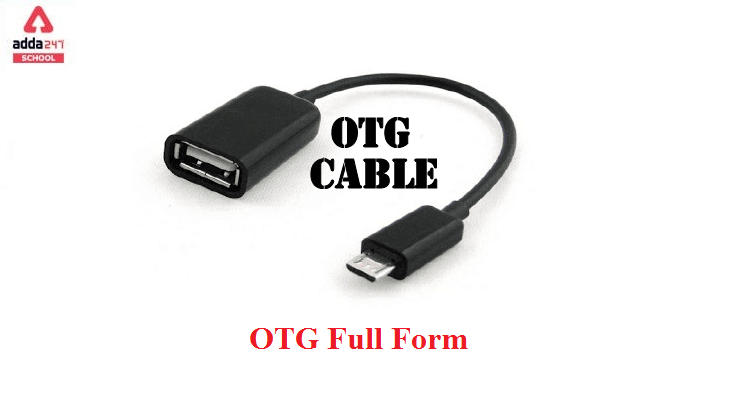Table of Contents
OTG Full form
OTG, stands for On-The-Go. The USB On-The-Go specification is a USB specification. The first USB OTG device is thought to have been used in late 2001. USB OTG, without the use of a computer, allows USB devices, such as tablets and smartphones, to function as a host. This means that other USB devices, such as flash drives, digital cameras, mice, and keyboards, can be connected to tablets and smartphones via USB OTG. The use of USB OTG allows the previously described devices to swap back and forth between host and device roles.
OTG Full Form in Hindi
ओटीजी का फुल फॉर्म, ऑन-द-गो के लिए है।
यूएसबी ऑन-द-गो विनिर्देश एक यूएसबी विनिर्देश है। माना जाता है कि पहला यूएसबी ओटीजी डिवाइस 2001 के अंत में इस्तेमाल किया गया था। यूएसबी ओटीजी, कंप्यूटर के उपयोग के बिना, यूएसबी डिवाइस, जैसे टैबलेट और स्मार्टफोन, को होस्ट के रूप में कार्य करने की अनुमति देता है। इसका मतलब है कि अन्य यूएसबी डिवाइस, जैसे फ्लैश ड्राइव, डिजिटल कैमरा, चूहों और कीबोर्ड को यूएसबी ओटीजी के माध्यम से टैबलेट और स्मार्टफोन से जोड़ा जा सकता है। यूएसबी ओटीजी का उपयोग पहले वर्णित उपकरणों को मेजबान और डिवाइस भूमिकाओं के बीच आगे और पीछे स्वैप करने की अनुमति देता है।
Read About: USB Full Form
OTG Cables
When two USB devices are connected, one of which is a USB OTG device, a communication link is established, and the device that controls the link is referred to as the master or host, while the other is referred to as the slave or peripheral.
OTG A-device and OTG B-device are the two roles that USB OTG assigns to devices. These are used to define which side of the link supplies electricity and which is the host at first. In the default link setup, an OTG A-device acts as a USB host and a power source, while an OTG B-device acts as a power consumer and a USB peripheral. Using the Host Negotiation Protocol, often abbreviated as HNP, the host and peripheral modes can be switched later.
OTG USB
USB OTG is a supplement to the Universal Serial Bus (USB) 2.0 specification, which was first agreed upon in late 2001 and has since been amended. The most recent version of the supplement additionally defines behaviour for an Embedded Host with specific abilities and a USB Standard-A port similar to that found on PCs.
The USB OTG and Embedded Host Supplement to the USB 3.0 specification support SuperSpeed OTG devices, Embedded Hosts, and peripherals.
OTG Targeted Peripheral List
TPL stands for Targeted Peripheral List, which is the full form of the abbreviation. TLP is used to direct a host device’s attention to specific products or applications. As is the case with normal PCs, a manufacturer’s targeted peripheral list has no bearing on its ability to perform as a general-purpose host. The targeted peripheral list of a manufacturer specifies the products supported by the “targeting” host, outlining what it must provide, such as output power, transfer speeds, compatible protocols, and device classes. All targeted hosts, including OTG devices functioning as hosts and embedded hosts, are affected.
OTG Types of Plugs
Mini OTG plugs
The original USB OTG specification had a mini-AB plug receptacle. Later iterations replaced it with micro-AB. It can be plugged in with either a mini-A or mini-B socket. Mini-A adapters also allow you to connect to Standard-A USB connections from accessories.
When a mini-A plug is inserted, the gadget becomes an OTG A-device. Furthermore, when a mini-B connector is attached, the gadget becomes a B-device. The condition of the ID pin detects the type of plug entered.
Pure mini-A receptacles are also available, which are utilised when a tiny host port is required, however, they do not enable OTG.
Micro plugs for OTG
Micro-AB was created with the introduction of the USB micro connector. It may take either a micro-A or a micro-B connector. Micro-A adapters connect to Standard-A connectors, which are commonly found on fixed or standard devices. A single micro-AB receptacle and no extra USB receptacles are required on an OTG device.
On one end of an OTG cable is a micro-A plug, and on the other end is a micro-B plug. The OTG connector extends the regular USB connector by a fifth pin. It’s known as the ID-pin. When a micro-A plug is inserted, the device becomes an OTG A-device, and when a micro-B plug is inserted, the device becomes a B-device. The condition of the pin ID detects the type of plug entered.
OTG Oven Full Form & use for baking
A traditional oven is essentially a smaller version of an oven, toaster, and grill (OTG), thus an OTG oven is larger than traditional ovens. It cooks food with hot coils and requires significantly less setup. The thermostat of the OTGs aids in temperature control, ensuring that the food is properly cooked or heated.
OTG Oven Full Form
एक पारंपरिक ओवन अनिवार्य रूप से एक ओवन, टोस्टर और ग्रिल (ओटीजी) का एक छोटा संस्करण है, इस प्रकार एक ओटीजी ओवन पारंपरिक ओवन से बड़ा होता है। यह गर्म कॉइल के साथ खाना बनाती है और इसके लिए काफी कम सेटअप की आवश्यकता होती है। ओटीजी का थर्मोस्टेट तापमान नियंत्रण में सहायता करता है, यह सुनिश्चित करता है कि भोजन ठीक से पकाया या गर्म किया गया है।
Related Post:
| CBSE Full Form | ICSE Full Form |
| CEO Full Form | SOP Full Form |
| AM PM Full Form | ACP Full Form |



 UP, MP, CBSE Board Result 2025 Live Upda...
UP, MP, CBSE Board Result 2025 Live Upda...
 CUET UG Exam Date Sheet 2025 @cuet.nta.n...
CUET UG Exam Date Sheet 2025 @cuet.nta.n...
 NEET UG 2025: Is NEET Previous years Que...
NEET UG 2025: Is NEET Previous years Que...










